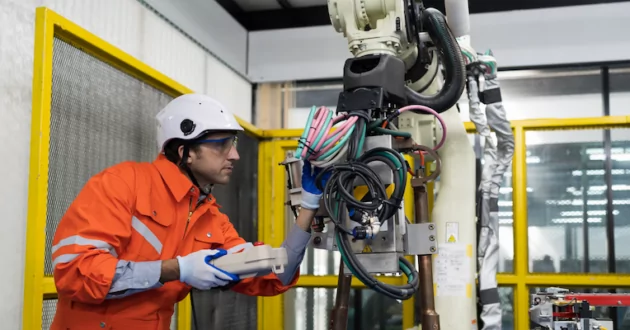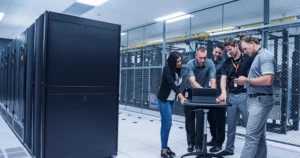
To achieve a step-change in business performance, organizations are combining technology modernization and sustainability into their core business processes. To do this requires improving user support tools that can help business leaders with the increasingly complex decisions needed to optimize across cost, service level, working capital and sustainability.
Generative AI is a catalyst for transforming business, and the technology is capturing the attention of business leaders around the world. As CEOs respond and embrace generative AI, they are faced with the Herculean task of both moving at pace—responsibly—while maintaining business, employee and shareholder trust.
What CEOs are saying about generative AI
The annual CEO study*, CEO decision-making in the age of AI, Act with intention, found that 75% of CEOs surveyed believe that competitive advantage will depend on who has the most advanced generative AI.
CEOs identify productivity or profitability as their highest business priority—up from sixth place in 2022, according to the IBM Institute for Business Value’s new CEO study. These leaders also recognize technology modernization is key to achieving their productivity goals, ranking it as their second highest priority. Yet CEOs face key barriers as they race to modernize and adopt new technologies like generative AI.
CEOs firmly believe in the benefits of generative AI across their organization but, when it comes to AI readiness, there appears to be a disconnect with their executive teams. While 69% of CEO respondents see broad benefits of generative AI across their organization, just 29% of their executive teams agree they have the in-house expertise to adopt generative AI.
What does a struggle with AI mean for sustainability?
Despite a shift in their priorities, sustainability remains a key challenge for business leaders. CEOs cite environmental sustainability as their top challenge over the next three years. What is preventing executives from moving the needle towards their larger goals? Leaders point to factors such as struggling to manage manual data, unclear ROI and economic benefits, lack of insights from data, and regulatory barriers as the top three biggest challenges in achieving sustainability objectives.
The fact is, sustainability and profitability can go hand-in-hand. Forward-thinking organizations are leveraging sustainability as an opportunity to drive their business forward and establish greater transparency around their sustainability commitments.
Creating a balanced sustainability/profitability roadmap is a powerful first step to driving organizations forward during the age of AI. This roadmap can help leaders identify opportunities and gaps in the current IT environment, which will help with more informed decision-making. Applying data and AI against sustainability goals is one way leaders can help drive productivity.
It appears that corporate boardrooms are taking note of the connection between sustainability and profitability and are holding CEOs accountable for their company’s sustainability efforts. In fact, the percentage of CEOs with compensation linked to specific sustainability measures has more than tripled from 2022 to more than 50% this year.
Modernizing IT environments can help organizations make sense of their data and progress towards their sustainability goals in several ways, including:
- AI implementation that automates manual data and transforms it into usable outputs without compromising the data’s security or reliability
- Green IT solutions that can help reduce an enterprise’s IT carbon footprint and even reduce up to 30% of computing costs
- Advanced analytics platforms that provide transparent sustainability data management across value chains with a single point of truth for sustainability analysis data and create greater transparency
Learn more about sustainability, CEOs and the role of AI
Sustainability is still a team sport, and it takes leadership across the enterprise to bring real, sustainable change. It is imperative that CEOs and other decision-makers consider sustainability as an imperative and business driver.
Learn how CEOs leverage technology to meet business demands Learn more about IBM Consulting Sustainability Services*Methodology
The IBM Institute for Business Value, in cooperation with Oxford Economics, interviewed 3,000 CEOs from over 30 countries and 24 industries as part of the 28th edition of the IBM C-Suite Study series. These conversations focused on executives’ perspectives on leadership and business; their changing roles and responsibilities; and CEO decision making today, including key challenges and opportunities, their use of technology, data and metrics, and their visions for the future. The IBM Institute for Business Value also conducted a survey of 200 CEOs in the United States on their responses to generative AI.
More from Sustainability

CMMS vs. EAM: Two asset management tools that work great together
6 min read - Most organizations can’t run without physical assets. Machinery, equipment, facilities and vehicles provide economic value or benefit operations. In most cases, they are fundamental to the performance of the organization, regardless of whether they are small-scale laptop portfolios or vast transportation networks. Energy companies rely on uninterrupted power supplies, airlines aim to ensure passenger safety, hospitals must provide quality patient care, haulage companies need up-to-date data on spare parts to maintain service levels. Organizations can’t work effectively if they don’t…

Building resilient healthcare supply chains
3 min read - In the healthcare supply chain, there are three main challenges pharmacies, hospitals, pharmaceutical companies and patients are facing: shortages and delays; lack of convenient and cost-effective fulfillment options; and rising counterfeiting and regulatory changes, along with a persistent need for better drug cold chain management. These struggles are inconvenient, adversely impact the quality-of-care patients receive and increase staff stress levels. How can healthcare supply chain professionals triage these concerns? By building resilient supply chains. Facts about healthcare supply chains According…

Supply chain visibility in the energy and utilities industry
3 min read - For the energy and utilities industry (E&U), time is not on their side. Equipment-heavy and reliant on an aging infrastructure, E&U clients suffer from costly supply chain disruptions as wear, tear and time take their toll. But with the right tools, tactics and collaboration, it doesn’t have to be this way. The key? Visibility. Simply knowing what maintenance repair parts, you have in-stock, at what levels, and in which locations, can mitigate a big portion of the possibility of unexpected…

Building a sustainable automotive supply chain
3 min read - The average age of the US light vehicle fleet is now more than 12 years old, which means that they are going to need parts for maintenance sooner rather than later. Pair that with a semiconductor shortage amidst global car sales that are forecasted to top 69 million, and you can understand that disruptions in the automotive supply chain would be detrimental to the industry. Many companies are beginning to recognize that rebuilding supply networks is imperative to remain viable in a rapidly…
- SEO Powered Content & PR Distribution. Get Amplified Today.
- PlatoData.Network Vertical Generative Ai. Empower Yourself. Access Here.
- PlatoAiStream. Web3 Intelligence. Knowledge Amplified. Access Here.
- PlatoESG. Automotive / EVs, Carbon, CleanTech, Energy, Environment, Solar, Waste Management. Access Here.
- BlockOffsets. Modernizing Environmental Offset Ownership. Access Here.
- Source: https://www.ibm.com/blog/sustainability-in-the-age-of-ai/
- :has
- :is
- :not
- $UP
- 000
- 200
- 2022
- 2023
- 24
- 28
- 30
- 300
- 31
- 32
- 39
- 40
- 80
- 9
- a
- About
- According
- accountable
- Achieve
- achieving
- across
- Act
- adopt
- advanced
- ADvantage
- adversely
- Advertising
- against
- age
- Aging
- AI
- aim
- Airlines
- All
- along
- also
- amidst
- amp
- an
- analysis
- analytics
- and
- annual
- Applying
- ARE
- around
- article
- AS
- asset
- asset management
- Assets
- At
- attention
- author
- automates
- automotive
- average
- back
- barriers
- BE
- Beginning
- believe
- benefit
- benefits
- Better
- between
- Big
- Biggest
- Blog
- body
- both
- bring
- broad
- Building
- business
- business performance
- business processes
- but
- by
- C-suite
- CAN
- capital
- Capturing
- car
- carbon
- carbon footprint
- card
- Cards
- care
- cases
- CAT
- Catalyst
- ceo
- CEOs
- chain
- chains
- challenge
- challenges
- change
- Changes
- changing
- check
- class
- clients
- cold
- collaboration
- color
- combining
- comes
- commitments
- Companies
- Company’s
- Compensation
- competitive
- complex
- compromising
- computing
- Concerns
- conducted
- connection
- Consider
- consulting
- Container
- continue
- Convenient
- conversations
- cooperation
- Core
- Corporate
- Cost
- cost-effective
- costly
- counterfeiting
- countries
- create
- CSS
- Current
- custom
- data
- data management
- Date
- decision
- Decision Making
- decision-makers
- decisions
- Default
- definitions
- delays
- description
- disruptions
- do
- does
- Doesn’t
- drive
- driver
- driving
- drug
- during
- Economic
- economic value
- Economics
- edition
- effectively
- efforts
- embrace
- Employee
- energy
- ensure
- Enter
- Enterprise
- Environment
- environmental
- Environmental Sustainability
- environments
- equipment
- establish
- Ether (ETH)
- Even
- executive
- executives
- Exit
- expertise
- Face
- faced
- facilities
- facing
- fact
- factors
- factory
- facts
- firmly
- First
- FLEET
- focused
- follow
- fonts
- Footprint
- For
- Forward
- forward-thinking
- found
- from
- fulfillment
- fundamental
- future
- gaps
- generative
- Generative AI
- generator
- Global
- Go
- Goals
- going
- great
- greater
- Grid
- Have
- healthcare
- height
- help
- highest
- holding
- hospitals
- How
- HTTPS
- IBM
- ICO
- ICON
- identify
- if
- image
- Impact
- imperative
- implementation
- improving
- in
- Including
- Increase
- increasingly
- index
- industries
- industry
- informed
- Infrastructure
- insights
- Institute
- interviewed
- into
- IT
- jpg
- june
- just
- Key
- Knowing
- Lack
- laptop
- large
- larger
- later
- leaders
- Leadership
- Level
- levels
- Leverage
- leveraging
- like
- linked
- locations
- machinery
- Main
- maintain
- maintaining
- maintenance
- make
- Making
- management
- Management Tools
- managing
- managing partner
- manual
- manufacturing
- many
- max-width
- mean
- means
- measures
- Meet
- Metrics
- million
- min
- minutes
- Mitigate
- Mobile
- modernization
- modernize
- more
- most
- moving
- must
- Navigation
- Need
- needed
- networks
- New
- New CEO
- New technologies
- next
- nothing
- now
- objectives
- of
- Old
- on
- on leadership
- ONE
- Operations
- opportunities
- Opportunity
- Optimize
- optimized
- Options
- or
- organization
- organizations
- Other
- over
- Oxford
- page
- pair
- part
- partner
- parts
- patient
- patient care
- patients
- percentage
- performance
- perspectives
- Pharmaceutical
- PHP
- physical
- Place
- Platforms
- plato
- Plato Data Intelligence
- PlatoData
- plugin
- Point
- policy
- portfolios
- position
- possibility
- Post
- power
- powerful
- preventing
- priority
- processes
- productivity
- professionals
- profitability
- Progress
- provide
- quality
- Race
- Ranking
- rather
- Readiness
- Reading
- real
- rebuilding
- receive
- recognize
- reduce
- Regardless
- regulatory
- rely
- remain
- remains
- repair
- requires
- resilient
- Respond
- respondents
- responses
- responsibilities
- responsive
- right
- rising
- roadmap
- robots
- ROI
- Role
- roles
- Run
- s
- Safety
- sales
- saying
- Screen
- scripts
- Second
- security
- see
- semiconductor
- sense
- seo
- Series
- service
- several
- shareholder
- shift
- shortage
- shortages
- side
- simply
- single
- site
- sixth
- small
- Solutions
- specific
- Sponsored
- Sport
- Staff
- start
- States
- Step
- Still
- stress
- Struggle
- Struggles
- Struggling
- Study
- such
- supply
- supply chain
- Supply Chain Visibility
- Supply chains
- support
- Survey
- surveyed
- Sustainability
- sustainable
- tactics
- Take
- takes
- taking
- Task
- team
- teams
- Technologies
- Technology
- than
- that
- The
- The Future
- the world
- their
- theme
- There.
- These
- they
- this
- this year
- three
- time
- Title
- to
- today
- together
- tools
- top
- towards
- transforming
- transforms
- Transparency
- transparent
- transportation
- triage
- Trust
- truth
- TURN
- two
- type
- understand
- United
- United States
- up-to-date
- URL
- us
- usable
- use
- User
- utilities
- value
- Vast
- vehicle
- Vehicles
- viable
- visibility
- visions
- vs
- W
- Way..
- ways
- What
- What is
- when
- whether
- which
- while
- WHO
- will
- with
- without
- WordPress
- Work
- worker
- working
- world
- would
- Wright
- written
- XML
- year
- years
- yet
- you
- zephyrnet












